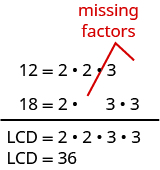Learning Outcomes
- Add or subtract fractions with different denominators
- Identify and use fraction operations
To add or subtract fractions with different denominators, we first must write them as equivalent fractions having the same denominator. We’ll use the techniques from the previous section to find the LCM of the denominators of the fractions. Recall that we call this the LCD (the least common denominator). We only use the denominators of the fractions, not the numerators, when finding the LCD.
Then we can use the Equivalent Fractions Property to algebraically change a fraction to an equivalent one. Remember, two fractions are equivalent if they have the same value. The steps for finding the LCD and the Equivalent Fractions Property are repeated below for reference.
Least Common Denominator
The least common denominator (LCD) of two fractions is the least common multiple (LCM) of their denominators.
Equivalent Fractions Property
If [latex]a,b,c[/latex] are whole numbers where [latex]b\ne 0,c\ne 0,\text{then}[/latex]
[latex]\Large\frac{a}{b}=\Large\frac{a\cdot c}{b\cdot c}\normalsize\text{ and }\Large\frac{a\cdot c}{b\cdot c}=\Large\frac{a}{b}[/latex]
Once we have converted two fractions to equivalent forms with common denominators, we can add or subtract them by adding or subtracting the numerators. Try the examples and practice problems below to refresh these skills.
Add or subtract fractions with different denominators
- Find the LCD.
- Convert each fraction to an equivalent form with the LCD as the denominator.
- Add or subtract the fractions.
- Write the result in simplified form.
Example
Add: [latex]\Large\frac{1}{2}+\Large\frac{1}{3}[/latex]
Solution:
| [latex]\Large\frac{1}{2}+\Large\frac{1}{3}[/latex] | |
| Find the LCD of [latex]2[/latex], [latex]3[/latex]. |  |
| Change into equivalent fractions with the LCD [latex]6[/latex]. | [latex]\Large\frac{1\cdot\color{red}{3}}{2\cdot\color{red}{3}} +\Large\frac{1\cdot\color{red}{2}}{3\cdot\color{red}{2}}[/latex] |
| Simplify the numerators and denominators. | [latex]\Large\frac{3}{6}+\Large\frac{2}{6}[/latex] |
| Add. | [latex]\Large\frac{5}{6}[/latex] |
Remember, always check to see if the answer can be simplified. Since [latex]5[/latex] and [latex]6[/latex] have no common factors, the fraction [latex]\Large\frac{5}{6}[/latex] cannot be reduced.
Try It
Watch the following video to see more examples and explanation about how to add two fractions with unlike denominators.
Example
Subtract: [latex]\Large\frac{1}{2}-\left(-\Large\frac{1}{4}\right)[/latex]
Try It
The following video provides two more examples of how to subtract two fractions with unlike denominators.
Example
Add: [latex]\Large\frac{7}{12}+\Large\frac{5}{18}[/latex]
Try It
When we use the Equivalent Fractions Property, there is a quick way to find the number you need to multiply by to get the LCD. Write the factors of the denominators and the LCD just as you did to find the LCD. The “missing” factors of each denominator are the numbers you need.

The LCD, [latex]36[/latex], has [latex]2[/latex] factors of [latex]2[/latex] and [latex]2[/latex] factors of [latex]3[/latex].
Twelve has two factors of [latex]2[/latex], but only one of [latex]3[/latex] —so it is ‘missing‘ one [latex]3[/latex]. We multiplied the numerator and denominator of [latex]\Large\frac{7}{12}[/latex] by [latex]3[/latex] to get an equivalent fraction with denominator [latex]36[/latex].
Eighteen is missing one factor of [latex]2[/latex] —so you multiply the numerator and denominator [latex]\Large\frac{5}{18}[/latex] by [latex]2[/latex] to get an equivalent fraction with denominator [latex]36[/latex]. We will apply this method as we subtract the fractions in the next example.
Example
Subtract: [latex]\Large\frac{7}{15}-\Large\frac{19}{24}[/latex]
Try It
Example
Add: [latex]-\Large\frac{11}{30}+\Large\frac{23}{42}[/latex]
Try It
Candela Citations
- Question ID: 146262, 146264, 146265, 146266, 146267, 146268. Authored by: Alyson Day. License: CC BY: Attribution. License Terms: IMathAS Community License CC-BY + GPL
- Revision and Adaptation. Provided by: Lumen Learning. License: CC BY: Attribution
- Ex: Add Fractions with Unlike Denominators (Basic with Model). Authored by: James Sousa (mathispower4u.com). Located at: https://youtu.be/zV4q7j1-89I. License: CC BY: Attribution
- Example: Subtract Fractions with Unlike Denominators. Authored by: James Sousa (mathispower4u.com). Located at: https://youtu.be/aXlkygPPzQ8. License: CC BY: Attribution
- Prealgebra. Provided by: OpenStax. License: CC BY: Attribution. License Terms: Download for free at http://cnx.org/contents/caa57dab-41c7-455e-bd6f-f443cda5519c@9.757




